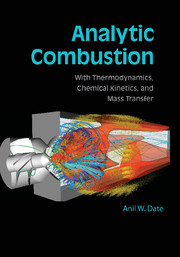Book contents
- Frontmatter
- Contents
- Preface
- Symbols and Acronyms
- 1 Introduction
- 2 Thermodynamics of a Pure Substance
- 3 Thermodynamics of Gaseous Mixtures
- 4 Chemical Equilibrium
- 5 Chemical Kinetics
- 6 Derivation of Transport Equations
- 7 Thermochemical Reactors
- 8 Premixed Flames
- 9 Diffusion Flames
- 10 Combustion of Particles and Droplets
- 11 Combustion Applications
- APPENDIX A Thermochemistry Data
- APPENDIX B Curve-Fit Coefficients for Δhc, Tad, Kp, Cp, h, and s
- APPENDIX C Properties of Fuels
- APPENDIX D Thermophysical and Transport Properties of Gases
- APPENDIX E Atmospheric Data
- APPENDIX F Binary Diffusion Coefficients at 1 atm and T = 300K
- Bibliography
- Index
11 - Combustion Applications
- Frontmatter
- Contents
- Preface
- Symbols and Acronyms
- 1 Introduction
- 2 Thermodynamics of a Pure Substance
- 3 Thermodynamics of Gaseous Mixtures
- 4 Chemical Equilibrium
- 5 Chemical Kinetics
- 6 Derivation of Transport Equations
- 7 Thermochemical Reactors
- 8 Premixed Flames
- 9 Diffusion Flames
- 10 Combustion of Particles and Droplets
- 11 Combustion Applications
- APPENDIX A Thermochemistry Data
- APPENDIX B Curve-Fit Coefficients for Δhc, Tad, Kp, Cp, h, and s
- APPENDIX C Properties of Fuels
- APPENDIX D Thermophysical and Transport Properties of Gases
- APPENDIX E Atmospheric Data
- APPENDIX F Binary Diffusion Coefficients at 1 atm and T = 300K
- Bibliography
- Index
Summary
Introduction
As mentioned in Chapter 1, the main purpose of combustion science is to aid in performance prediction or design of practical equipment, as well as to aid in prevention of fires and pollution. This is done by analyzing chemical reactions with increasing refinements, namely, stoichiometry, chemical equilibrium, chemical kinetics, and, finally, fluid mechanics. Such, analyses of practical equipment are accomplished by modeling. The mathematical models can be designed to varying degrees of complexity, starting from simple zero-dimensional thermodynamic stirred-reactor models to one-dimensional plug-flow models and, finally, to complete three-dimensional models. At different levels of complexity, the models result in a system of a few algebraic equations, a system of ordinary differential equations, or a system of partial differential equations.
Practical combustion equipment typically has very complex geometry and flow paths. The governing equations of mass, momentum, and energy must be solved with considerable empirical inputs. The size of the mathematical problem is dictated by the reaction mechanism chosen and by the chosen dimensionality of the model. The choice of the model thus depends on the complexity of the combustion phenomenon to be analyzed, the objectives of the analysis, and the resources available to track the mathematical problem posed by the model.
In this chapter, a few relevant problems are formulated and solved as case studies to help in understanding of the art of modeling as applied to design and performance prediction of practical combustion equipment.
- Type
- Chapter
- Information
- Analytic CombustionWith Thermodynamics, Chemical Kinetics and Mass Transfer, pp. 261 - 294Publisher: Cambridge University PressPrint publication year: 2011



